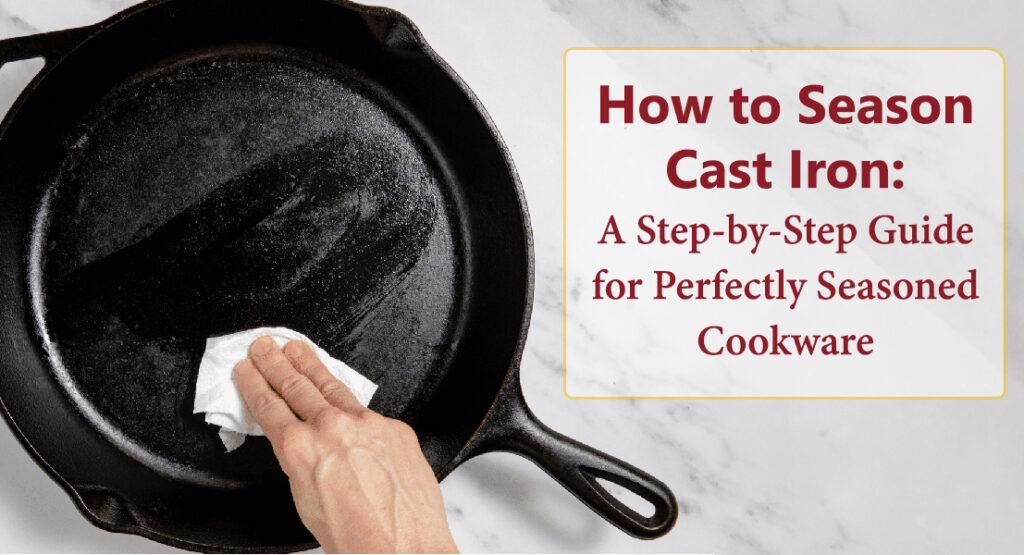Cast iron cookware is known for its durability and its ability to develop a natural non-stick surface over time. However, to get the best results, you need to season it properly. Seasoning a cast iron pan involves creating a layer of hardened oil on the surface, protecting it from rust and giving it a smooth, non-stick finish. This guide will take you through everything you need to know to season cast iron like a pro, from choosing the right oil to maintaining the seasoning over time.

Why Seasoning is Important for Cast Iron
Seasoning is essential for cast iron because it prevents rust and creates a natural, easy-release surface. Unlike coated cookware, cast iron is porous, so it can easily rust or trap food if not properly treated. Seasoning fills these tiny pores with oil, which then hardens into a smooth, protective layer when heated. The result is a shiny, non-stick surface that becomes more effective the more you cook with it.
How Does Seasoning Work?
Seasoning works through a process called polymerization. When oil is heated to a high temperature, it bonds to the metal, creating a hardened, protective coating. Over time, this layer builds up, making the cast iron more durable and non-stick. Each time you season the pan, the layer of oil strengthens, enhancing its performance.
Step 1: Gather Your Materials
Before you start seasoning your cast iron, gather the following materials:
- Cast iron pan or skillet: Make sure it’s clean and dry.
- Oil: Use a high-smoke-point oil such as flaxseed oil, canola oil, vegetable oil, or grapeseed oil.
- Paper towels or a cloth: To apply and wipe off excess oil.
- Aluminum foil: For easy cleanup in the oven.
- Oven or stovetop: To heat and set the oil on the cast iron surface.
Step 2: Clean the Cast Iron
If your cast iron pan is new, you’ll likely need to remove any factory residue. For older pans, it’s essential to start with a clean surface before seasoning. Here’s how to clean it properly:
- Wash the pan with warm water: Use a small amount of mild dish soap and a sponge if needed.
- Scrub gently: If there’s any rust, use a stiff brush or steel wool to scrub it off. Avoid soaking the pan in water, as cast iron rusts easily.
- Rinse and dry thoroughly: After rinsing, dry the pan completely with a towel. You can also place it on the stove over low heat for a few minutes to ensure all moisture evaporates.
Step 3: Apply a Thin Layer of Oil
Once your cast iron is clean and dry, it’s time to apply oil. This is the most crucial step in seasoning cast iron.
- Pour a small amount of oil onto the pan: Just a few drops will do. It’s best to start with a thin layer, as too much oil can create a sticky, uneven finish.
- Rub the oil into the pan: Use a paper towel or cloth to spread the oil over the entire surface, including the inside, outside, and handle.
- Wipe off the excess: Once you’ve coated the pan, use a clean paper towel to wipe away any excess oil. You should end up with a thin, almost invisible layer of oil on the pan.
Step 4: Heat the Cast Iron to Set the Seasoning
Heating the pan will bond the oil to the cast iron, creating that sought-after seasoning layer. There are two common ways to do this: in the oven or on the stovetop.
Method 1: Using the Oven
- Preheat the oven to 450°F (232°C): This high temperature will ensure the oil reaches its smoke point and bonds to the cast iron.
- Place aluminum foil on the lower rack: The foil will catch any oil drips, preventing mess in your oven.
- Place the pan upside down on the top rack: This helps prevent oil from pooling and ensures an even seasoning.
- Bake for 1 hour: Let the pan heat for an hour to fully set the oil.
- Turn off the oven and cool: Once the hour is up, turn off the oven and let the pan cool inside. This gradual cooling helps the seasoning set.
Method 2: Using the Stovetop
- Heat the pan over medium-high heat: Place the pan on the stovetop and gradually heat it.
- Wait for the pan to smoke: As the pan heats, the oil will begin to smoke slightly. This is a sign that the oil is bonding to the metal.
- Remove from heat and cool: After a few minutes of smoking, remove the pan from the heat and let it cool. This method works well for quick touch-ups but isn’t as thorough as the oven method.
Step 5: Repeat the Process (Optional)
For a stronger seasoning layer, repeat the oiling and heating steps several times. Each round adds another layer of protection, making the pan more non-stick. You may find that new or heavily restored pans benefit from 2–3 rounds of seasoning.
Maintenance: How to Care for Seasoned Cast Iron
Proper care will help you maintain the seasoning on your cast iron. Follow these tips to keep your pan in top shape:
- Avoid Soap: After the initial cleaning, avoid using soap, as it can strip away the seasoning. Use hot water and a brush or scraper to clean the pan after each use.
- Dry Immediately: After washing, dry the pan completely. Leaving it wet can cause rust.
- Apply a Light Oil Coat: After each wash, rub a very light coat of oil over the surface. Heat it briefly to help absorb the oil and maintain the seasoning.
- Store in a Dry Place: Avoid storing cast iron in humid environments, as this can lead to rust. Make sure it’s fully dry before storing it in a cupboard or drawer.
Re-seasoning When Needed
If your cast iron starts to lose its non-stick surface or develops rust, re-seasoning can restore it. Simply repeat the oiling and heating process, and your pan will regain its protective layer. Re-seasoning is also beneficial after cooking acidic foods, which can wear down the seasoning.
Common Mistakes to Avoid
Avoid these mistakes to get the best seasoning results:
- Using too much oil: A thick layer of oil creates a sticky surface instead of a smooth one. Use only a thin layer each time you season.
- Skipping the heating step: Heating the pan is crucial for polymerizing the oil. Without this step, the seasoning won’t bond to the cast iron.
- Leaving the pan wet: Never store cast iron wet. Dry it thoroughly after each wash to prevent rust.
Conclusion
Seasoning cast iron is simple but essential for maintaining its performance and longevity. By following these steps, you’ll create a durable, non-stick layer that enhances your cooking experience. Regular maintenance and occasional re-seasoning will keep your cast iron in excellent condition, ready for anything from searing to baking. With a well-seasoned cast iron pan, you’ll enjoy cooking with one of the most versatile and resilient tools in the kitchen.









